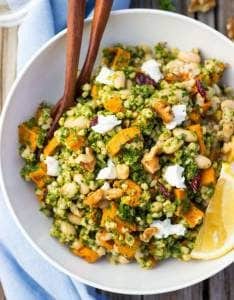Amaranth gets its name from the Greek amarantos meaning, “one that does not wither” or “the never-fading.” This grain grows in Mexico and other Central American Countries. The ideal environment to grow amaranth is located in this region because of the gentle rains and warm sun. This very tall plant has large green leaves with red, gold, or purple flowers. Amaranth has three species, each of which are commonly grown because of their edible seeds.
An interesting fact about Amaranth is that it is the only grain documented to contain vitamin C (13%). Besides vitamin C, amaranth is also high in iron (81%), potassium (28%), vitamin B6 (55%), and magnesium (119%). It also has a huge amount of calcium, in fact three times the average amount. Though not much research has been done on amaranths beneficial properties, studies done have focused on its role in a healthy diet. The three important reasons to add it to your diet are it is a protein powerhouse, it is beneficial to the heart, and it is naturally gluten free.
One way amaranth is a protein powerhouse is it contains 26 grams in just one cup. That is 52% of the daily recommended value. An amino acid that amaranth has that most grains do not is lysine, a protein building block. Lysine is beneficial in helping the body absorb calcium, burn fat, help maintain skin, tendons, bones, and cartilage. Many people will refer to amaranth as a “complete protein” because it contains lysine.
Over the last 14 years, multiple studies have been done showing amaranth as a cholesterol lowering whole grain too. Amaranth holds an oil that is very healthy. This oil has shown to help reduce the LDL and total cholesterol levels in a person. When people with cardiovascular disease and coronary heart disease used amaranth in their everyday diet, they saw significant decreases in total cholesterol, LDL, and triglycerides.
 Lastly, amaranth is gluten free! Within the past few years millions of people have changed their diets to gluten free. Some diet changes are out of preference, but many people cannot have gluten due to autoimmune disorders and celiac disease. Someone I know actually experiences gastrointestinal distress when they eat gluten. Gastrointestinal distress occurs when the gastrointestinal tract is not working properly but looks normal. Symptoms such as gas, diarrhea, irritable bowel syndrome, and constipation can occur.
Lastly, amaranth is gluten free! Within the past few years millions of people have changed their diets to gluten free. Some diet changes are out of preference, but many people cannot have gluten due to autoimmune disorders and celiac disease. Someone I know actually experiences gastrointestinal distress when they eat gluten. Gastrointestinal distress occurs when the gastrointestinal tract is not working properly but looks normal. Symptoms such as gas, diarrhea, irritable bowel syndrome, and constipation can occur.
Incorporating amaranth into your diet is very simple as well. There are tons of yummy recipes out there ranging from soups, muffins, to quiche. One that really stood out to me was amaranth banana walnut bread. YUM. This recipe includes two of my favorite things, bananas and honey. Plus, who doesn’t love a nice, warm, succulent bread.
If you are looking to buy amaranth, most local grocery stores such as Walmart carry it. You can also find it at most health food stores and even Amazon!



